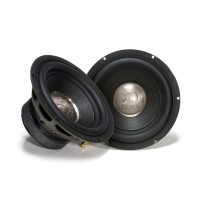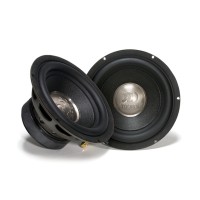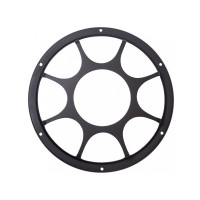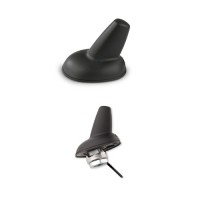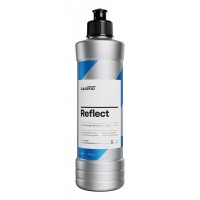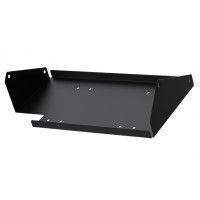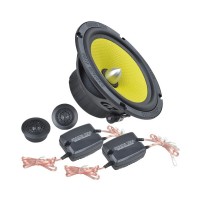Subwoofer Morel Primo 124
More about the product
- Use our consulting room
- You can return the goods to us within 14 days
- Try the product at our store
Subwoofer Morel Primo 124
Based on the great success of the Ultimo model series subwoofers, the new Primo series has been designed for everyone who expects high quality Morel sound at a more affordable price. Primo subwoofers are available in 8", 10" and 12" sizes and feature a laminated paper diaphragm and a solid rubber suspension. High-quality ferrite magnets and a two-inch copper-plated aluminum voice coil ensure the necessary linearity and musicality. Morel Primo subwoofers are optimized for closed and bass reflex enclosures and thanks to the high sensitivity it is not necessary to connect to very powerful amplifiers.EVC™ system
Morel speakers with EVC™ technology use voice coils that are up to three times larger than conventional speakers. The EVC™ design moves the magnetic drive system inside the voice coil and eliminates stray magnetic flux by effectively directing all magnetic energy into the voice coil. The result is an ultra efficient and powerful system that is highly compact with efficient heat dissipation and reduced membrane breakdown for less distortion.
Paper membrane
Used since the first historic loudspeakers, paper continues to be an exceptional material for transmitting quality sound. Morel's latest paper-composite diaphragms are ultra-lightweight, making the speakers more sensitive.
High frequency ferrite magnet
Ferrite magnets are most often used in loudspeakers. Although they look similar, there are several types of these magnets. Morel uses only the highest intensity magnets in its subwoofers. As a result, Morel's magnetic systems are highly compact yet deliver more magnetic flux than conventional ferrite magnets.
| Catalog number | PRIMO 124 |
| Brand | Morel |
| Links | Official web presentation |
| RMS powerThe RMS power of the subwoofer is the constant power of continuous use of the subwoofer. If the power is exceeded for a longer period of time, irreversible damage may occur, or to burn out the voice coil of the subwoofer. | 350 W |
| Max. (maximum performancePeak performance , which the subwoofer can play momentarily (approx. 0.5 s), for example when hitting drums in a song. If the maximum power is exceeded, damage can quickly occur, or to burn out the voice coil of the subwoofer. | 700 W |
| Sensitivity (SPL 2.83V/1m)Subwoofer sensitivity or efficiency. The sensitivity of the subwoofer is given in decibels (dB) and, in simple terms, means that the higher the value, the lower the demands on the power of the amplifier. This is a de facto rating of how a subwoofer converts watts to sound. Sensitivity ratings are in noise level measured at 1 meter from the subwoofer using 1 W (watt of power) or using 2.83 volts at the source at 1 meter. A higher decibel level means the subwoofer is louder with less power. For every 3 dB increase in sensitivity, the subwoofer requires half the power to reproduce the same volume. For example, if an 88 dB subwoofer needs 300 Watts to produce a certain volume, then a subwoofer with 91 dB sensitivity needs only 150 Watts to reach the same efficiency. | 91 dB |
| ImpedanceImpedance - measurement of electrical resistance. When buying a subwoofer, it is very important that everyone make sure that the impedance matches the amplifier that you are connecting to it. For subwoofers with a double voice coil, we recommend following the information in the advice center! Example: A 2 Ohm subwoofer cannot be connected to an amplifier that is only stable up to 4 Ohms. A 4 Ohm subwoofer can easily be used on an amplifier that is stable up to 2 Ohms. Connecting a 4 Ohm subwoofer to an amplifier that is stable up to 4 Ohms also without problems. The most common subwoofer impedance is 4 Ohm. | 4 Ω |
| Frequency rangeThe ability of the subwoofer to play a signal from the lowest frequency to the highest, or the ability of a subwoofer to faithfully reproduce sound in a specific frequency band. Subwoofers ideally play from 20 - 150 Hz. Professionally: In the frequency range from 40 to 16,000 Hz, the vast majority of fundamental and overtones (harmonics) of all musical instruments are found. We are interested in the course of the radiated sound pressure in this range of frequencies when the loudspeaker system is supplied with constant power. We call this course the frequency characteristic, which tells us the level of radiated sound pressure in decibels (dB) depending on the frequency. The frequency characteristic of a speaker or speaker system can be expressed most succinctly with a graph. Mostly, however, the frequency characteristic is indicated by indicating the maximum tolerance of the sound pressure in the given frequency range, e.g. 50 to 15,000 Hz -+ 6 dB. Since the frequency characteristics of loudspeakers and systems in general are quite uneven, some manufacturers do not even indicate this maximum tolerance of sound pressure in decibels in their catalogs for tactical reasons. Data impoverished in this way is unfortunately worthless. What is valid is that the manufacturer offers a speaker system with a frequency range of 30 to 20,000 Hz, if he is worried about stating the maximum unevenness of the sound pressure in this range, because he can have a tolerance of, for example, +- 20 dB. The unevenness or undulation of the frequency curve in good speaker systems for high-quality music performance should not exceed +-3 dB in the 80 to 12,000 Hz band and +-6 dB in the 40 to 16,000 Hz band. Greater unevenness already depletes or emphasizes certain tonal areas, which can cause audible or even disturbing distortion. The proportion between fundamental tones and higher harmonics also changes, thereby changing the color of the sound, and individual musical instruments as well as the entire musical image sound unnatural. | 20 - 900 Hz |
| Subwoofer diameterThe diameter of the subwoofer is indicated on the screw holes. The overall outer diameter of the subwoofer is usually 1-2 cm wider, depending on the size category of the subwoofer. For a 30 cm subwoofer, the outer diameter incl. protective rubber 31.8 cm and in the 25 cm subwoofer it is 26.5 cm incl. protective rubbers. | 300mm (12") |
| Subwoofer mounting depthThe mounting depth of the subwoofer is measured from the bottom edge of the magnet to the bottom edge of the subwoofer's metal or cast basket. | 143 mm |
| Recommended enclosure volumeThe closed enclosure is characterized by a simple construction. Closed enclosures are usually smaller than bass-reflex enclosures, and a special damping fleece is used for their damping. A closed baffle has the advantage of preventing an acoustic short between the front and back radiation of the subwoofer diaphragm. The disadvantage is that the closed enclosure raises the natural resonance frequency of the used subwoofer and thereby also increases the lower limit frequency. This is because the back side of the diaphragm is forced to compress and dilute the air inside the enclosure when the subwoofer is radiating in a closed enclosure. This adds to the inherent stiffness of the subwoofer's oscillation system the stiffness of the air in the closed enclosure. This causes an increase in the stiffness of the oscillating system and thus an increase in the resonant frequency of the entire system: subwoofer -> loudspeaker. The increase in resonant frequency for a given subwoofer is greater, the smaller the volume of air in the closed enclosure. The relatively small volume of air in the closed enclosure acts on the subwoofer as an acoustic spring when radiating the back side of the membrane into the enclosed enclosure. USE: Mainly for quality bass listening in the entire band with an emphasis on detail and accurate reproduction in the lower band. Pros and cons: + pure reproduction + small closets + easier tuning - low level of efficiency in deep bass - loudness only at the cost of enormous deflection of the membrane - a significant acoustic pressure cannot be expected | 27 - 52 l, optimally 38 l |
| Recommended bass reflex speaker volumeA bass reflex enclosure is designed in the same way as a closed enclosure, but it also has a so-called bass reflex mouthpiece, or "bass reflex" or slot. Needle foam is used to dampen bass reflex enclosures. USE: The ideal use is in cases where the listener wants to achieve a high volume and a good sound pressure level. It is the best compromise between sound quality and performance and is also the most commonly used Pros and cons: + good efficiency in deep bass + a small deflection of the membrane is enough for a large volume - reproduction less accurate than with closed enclosures | 42 - 71 l, optimally 57 l |
| Fs - resonant frequencyFs - is the lower resonant frequency. This parameter is the de facto free air resonant frequency of the subwoofer. Simply put, it is the point at which the weight of the subwoofer's moving parts equals the force of the subwoofer's suspension while it is in motion. If you've ever seen a piece of string start to hum uncontrollably in the wind, you've seen the effect of reaching a resonant frequency. The weight of the moving parts and the stiffness of the suspension (surround and spider) are key elements that affect the resonant frequency. As a general rule, a lower Fs indicates a subwoofer that would be better at reproducing low frequencies than a subwoofer with a higher Fs. However, this is not always the case, as other important parameters of the subwoofer also enter the resulting sound. | 28 Hz |
| Vas - equivalent volume of airVas - represents the volume of air that, when compressed per cubic meter, acts with the same force as compliance (CMS), suspension in a certain subwoofer. Vas is one of the most complicated parameters to measure, as changes in air pressure are affected by conditions of relative humidity and temperature. Another way to describe what VAS is: try using a subwoofer and find a baffle that is the right size to return the air with the same stiffness to the same resonance. The size of this box is equal to you. There are, of course, other parameters, but they are not so necessary for the exact calculation of the enclosure. Resonance frequency and Q-parameter values are also important when building enclosures. | 85 l |
| Xmax + -Xmax - the maximum deflection of the subwoofer diaphragm in one direction – it is not a sum, or an abbreviation for the maximum linear deflection. The subwoofer output becomes non-linear as the voice coil begins to leave the magnetic gap. | 8 mm |
| QesElectrical Q-factor of driver is the electrical quality factor (electrical damping). If the subwoofer coil moves in a magnetic field, it generates its own current that counteracts its movement. Qes is a dimensionless parameter and the lower the number, the higher the generated current and the more damped the coil movement, thus reducing the total current flowing through the coil, the deflection and the sensitivity around the fs resonance. It varies in values from 0.08 to 0.6, in the extremes, for ordinary universal converters, even 20. Subwoofers with too low a Qes value, a very damped system, are not suitable for certain types of enclosures. | 0.56 |
| QmsMechanical Q-factor of driver is a mechanical factor of quality (mechanical damping). These are mechanical losses affecting (damping) the movement of the subwoofer membrane. Qms is a dimensionless parameter and the higher the number, the smaller the losses, i.e. the deviation and sensitivity in the lower band is also higher, it ranges around 0.4 - 25. | 3.1 |
| QtsTotal Q-factor of driver is a total quality factor, it includes both parameters Qes and Qms (electrical Qes and mechanical Qms). It varies in values from approx. 0.08 to 0.6, exceptionally up to 3. The Qts of the subwoofer is calculated in the same way as, for example, a pair of parallel resistors, so the result is decisively influenced by a smaller value that cannot be exceeded, which is usually Qes. | 0.47 |
| Subwoofer voice coil diameterThe larger the diameter of the voice coil, the more load capacity the subwoofer has, in layman's terms. | 51 mm |
| Subwoofer diaphragm materialThe specific material from which the subwoofer membrane is made. | Laminated paper |
| MassSubwoofer weight in kilograms. The weight is usually given net, i.e. without packaging. | 4.7 kg |





